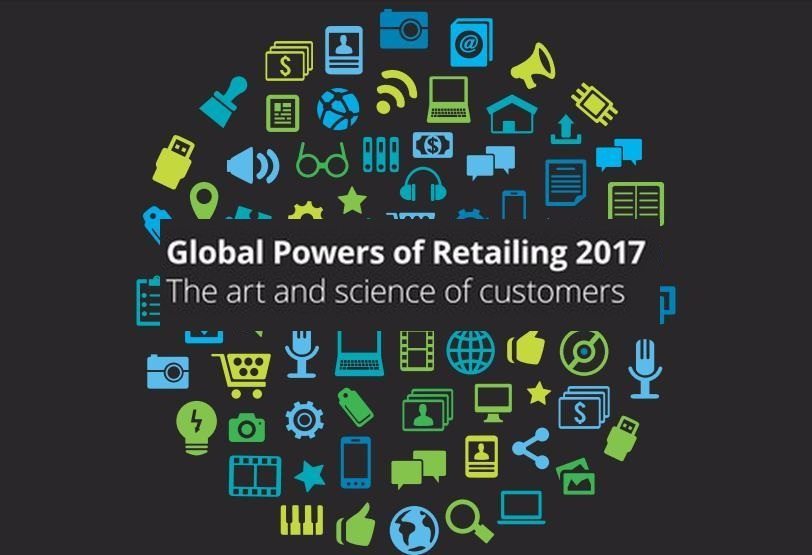
Public Voting for the RAU Awards 2025 Has Begun


 13.02.2017 10:00
13.02.2017 10:00Deloitte presented the annual report Global Powers of Retailing-2017. What will be waiting for retailers this year?
This report marks the 20th year of identifying the 250 largest retailers around the world and analyzing their performance across geographies, sectors, and channels. Over the last 20 years we have seen a seismic shift in retail and the customers that retailers serve. Consider that in 1997, the inaugural year of this report, today’s average Amazon Prime customer was just 16 years old, AOL was pioneering social media, and handheld virtual pets were the hottest-selling toys.
Today, handheld (or wearable) digital devices are ubiquitous and a younger, social customer has come of age.
We are living in an era where customers are in the driver’s seat more than ever before and they are craving authenticity, newness, convenience, and creativity. We are living in the customer-driven economy.
The retail trends for 2017 are focused squarely on understanding the art and science of catering to the customer. These focus on three main trend areas. The first is changing preferences, including the trend toward owning less and living in the social media-driven economy. The second is changing retail formats through the blurring of sectors and proliferation of on-demand fulfillment. The third is the transformative possibilities from living with exponential technologies, both in the store and beyond. While these trends are not new, what is interesting for 2017 is that what was once futuristic is now table stakes.
Retail innovators know technology is no longer supplemental to the shopping experience, it is fundamental. Technology alone, however, is not enough.
Customers are seeking new and surprising products and experiences. Retailers are increasingly challenged to find ways to delight their customers and strengthen loyalty. It is about mastering the art and science of customer engagement to design fresh experiences, enabled by technology.
Customers are defining themselves less by how many things they own and more by how curated their lives are in terms of possessions and experiences. “Fewer, Better Things” is the slogan for Cuyana, a San Francisco based e-commerce retailer which has found a market niche by selling customers high-quality, craftsman-made goods. The success of their “lean closet” approach reflects a change in customer preferences away from rampant consumption toward intentional consumption. Customers are defining themselves less by how many things they own and more by how curated their lives are in terms of possessions and experiences.
Consumption of ‘experiences’ has outpaced the consumption of ‘goods’ by a factor of three over the last two years. This means decreased share of wallet on non-durable and durable goods
(particularly apparel), as well as declining foot traffic at mass retailers and department stores. We are seeing a movement away from the mass-produced toward the “bespoke.” Traditional fast-fashion retailer H&M is responding by launching programs like “H&M Conscious” which will debut a new Conscious Exclusive collection of high-end, environmentally friendly pieces each year. This is a shift away from fast fashion’s traditional business model, built on customers buying more frequently at a lower price.
Customers are seeking experiences and products that reflect the personal brand they promote on social media. One potential reason for this movement toward less consumption is the growing awareness of how our purchases define us as customers. The trends toward personalization and customer experience are not new. What is new is the level to which we define ourselves by the products we buy and the experiences we have. For this, we can thank social media.
Customers worldwide are busy “following” celebrities and brands on social media and simultaneously building their own “following.”
They are seeking experiences and products that reflect the personal brand they promote on social media. This manifested initially in the travel and tourism sector. Resorts have focused on being “Instagrammable,” with Condé Nast now aggregating data on geotags and hashtags to inform their reviews. Hotel guests, particularly Millennials, value how their trips are perceived on social media as much as the actual quality of the real experience. This is now also playing out in retail.
Customers want authentic, sharable experiences to further their personal brand.
Retailers that can consistently deliver these moments will likely grow a fiercely loyal customer base. The power of sharable retail experiences can be seen with Australia’s T2, a super-premium tea shop. For the last five years, coffee sales (and the photogenic frothy latte) have outpaced tea sales in almost every country. T2 sought to change all that by bringing the “hip” back to tea. It designed packaging and in-store experiences that pop with vibrant colors and bold patterns, which make for visually appealing social media posts. T2 boasts a loyal social media following which helped it grow from one store in Melbourne in 1996 to a global brand, acquired by Unilever in 2013.
The maker movement, the sharing economy, and other factors have made it increasingly difficult to define what a retailer is and does. In years past, it was easy to spot a retailer. It bought and sold goods, either in store or online. The maker movement, the sharing economy, and other factors have made it increasingly difficult to define what a retailer is and does. In 2017 and beyond, market fragmentation in the retail space will continue to grow.
Some are attributing this volatility to “retailization” or the explosive growth of non-traditional retailers developing new models to serve customer needs.
This is playing out in the developing world, where large-scape leapfrogging is more common. In China, e-commerce power-players Alibaba and Tmall have competition from Vipshop, which has grown by popularizing the flash-sale model. It sells mid-market clothing and accessory brands, using a time-limited discount model. Interestingly, 90 percent of Vipshop’s sales are outside of China’s Tier 1 cities. In developing economies where customers are gaining purchasing power, there is a greater willingness to rely on less traditional retail models for more purchases.
In established markets, there is less dramatic market penetration from alternative formats, but the level of sector blurring is unprecedented. Low barriers to entry have led to the pop-up of new “retailers” like subscription model Dollar Shave Club, personalized clothing delivery service Trunk Club, and Blue Apron, a curated grocery and meal delivery service.
As disruption and alternative business models persist, retailers will need to reinvent themselves.
Home Shopping Network, one of the newcomers to our list this year, has done that quite successfully. HSN was born in 1982 as an American order-by-phone television network and has grown into a sophisticated multichannel global retailer. The company redeployed assets to build an innovative e-commerce platform, created digital content, and sought out new partners. HSN survived and thrived in an area of disruption by reinventing its business model to stay relevant.
Relevancy will be determined by the ability of retailers to meet the on-demand mindset of the modern customer. Relevancy will also be determined by the ability of retailers to meet the on-demand mindset of the modern customer. Amazon and other on-demand delivery options have forever altered customer expectations for fulfillment. This year, Amazon joined the list of top 10 global retailers for the first time. Amazon’s growth has been significantly driven by its prime service which attracts younger, higher income customers. While Amazon doesn’t disclose data on growth for its prime service, some estimate the number of worldwide members to be 80 million and growing at around 50 percent CAGR. Apparel and hardline retailers have already felt the effect of on-demand fulfillment and the frontier is shifting to grocery, automotive, and services. Europe will likely continue to be the battleground for the future of grocery. AmazonFresh rolled out one-hour delivery in 10 cities in the UK, as well as in major cities throughout Europe. Carrefour responded with its own one-hour delivery service in France, and likely will be followed by other European grocers.
Over the last three years the Netherlands, Germany, the UK and France have seen the highest growth rates for online grocery retail ranging from 20 to 50 percent CAGR.
In 2017, home delivery will become prolific in populated, wealthy, European cities, while “order online pick up in store” will grow in more rural parts of Europe. Speed alone, however, will not be enough to compete. Consumers have been conditioned to expect a high-quality, on-demand shopping experience. This includes real-time reviews and local partnerships to provide fresh products. Sprouts Farmers Market, another newcomer on our list this year, has partnered with Amazon to provide fresh products for Amazon Prime delivery in the Dallas area. One trend likely to continue is traditional grocers partnering with technology and delivery companies to provide products for on-demand delivery; with grocers effectively almost becoming vendors to technology companies.
Exponential technologies are changing how we live and how we will shop. The final trend is the arrival of exponential living. Much has been prophesized about the disruption coming from exponential technologies like artificial intelligence, robotics, sensors, and virtual reality. These technologies are no longer futuristic. The most innovative retailers are already using them to enhance interactions with customers and to change the way work gets done.
Expect the use of artificial intelligence or robotics for self-service in the store to continue.
Lowes is using OSHbot retail service robots in its Orchard Supply Hardware stores. The robot greets customers in English and Spanish, can scan products to determine whether the store has the item in stock and guides customers to products through store navigation capabilities. EBay, in partnership with Australian retailer Myer, has created the world’s first virtual reality department store. Using eBay Sight Search, consumers can explore over 12,500 products from Myer, access real-time price and product information, and add selected items to their basket.
The impact of technology is not limited to the in-store experience. Exponentials are changing how we live and how we will shop.
Consider the arrival of driverless cars and the potential impacts on behavior. Un-manned cars will allow smaller or hyper-local retailers to afford personal, same-day deliveries. Imagine buying your baked goods directly from the bakery, while they are still hot. Or being able to program your car to run errands to multiple stores and pick up everything on your shopping list. The impacts to the customer journey from self-driving cars are endless. The same impacts can be expected from the wide-scale adoption of augmented reality, 3D printing, holograms, and other technologies.
Read more –





